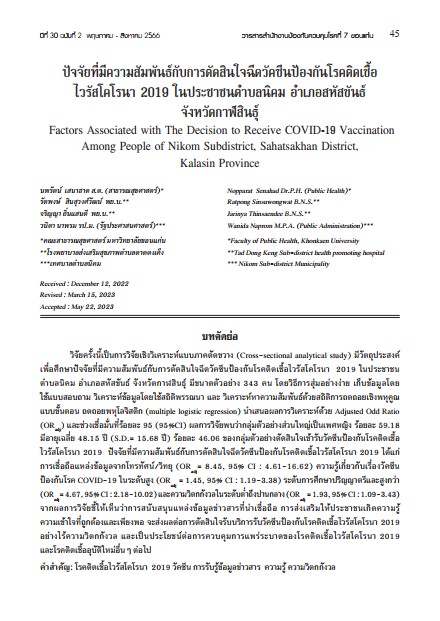ปัจจัยที่มีความสัมพันธ์กับการตัดสินใจฉีดวัคซีนป้องกันโรคติดเชื้อไวรัสโคโรนา 2019 ในประชาชนตำบลนิคม อำเภอสหัสขันธ์ จังหวัดกาฬสินธุ์
คำสำคัญ:
โรคติดเชื้อไวรัสโคโรน่า 2019, วัคซีน, การรับรู้ข้อมูลข่าวสาร, ความรู้, ความวิตกกังวลบทคัดย่อ
วิจัยครั้งนี้เป็นการวิจัยเชิงวิเคราะห์แบบภาคตัดขวาง (Cross-sectional analytical study) มีวัตถุประสงค์เพื่อศึกษาปัจจัยที่มีความสัมพันธ์กับการตัดสินใจฉีดวัคซีนป้องกันโรคติดเชื้อไวรัสโคโรนา 2019 ในประชาชนตำบลนิคม อำเภอสหัสขันธ์ จังหวัดกาฬสินธุ์ มีขนาดตัวอย่าง 343 คน โดยวิธีการสุ่มอย่างง่าย เก็บข้อมูลโดยใช้แบบสอบถาม วิเคราะห์ข้อมูลโดยใช้สถิติพรรณนา และ วิเคราะห์หาความสัมพันธ์ด้วยสถิติการถดถอยเชิงพหุคูณแบบขั้นตอน ถดถอยพหุโลจิสติก (multiple logistic regression) นำเสนอผลการวิเคราะห์ด้วย Adjusted Odd Ratio (ORadj) และช่วงเชื่อมั่นที่ร้อยละ 95 (95%CI) ผลการวิจัยพบว่ากลุ่มตัวอย่างส่วนใหญ่เป็นเพศหญิง ร้อยละ 59.18 มีอายุเฉลี่ย 48.15 ปี (S.D.= 15.68 ปี ) ร้อยละ 46.06 ของกลุ่มตัวอย่างตัดสินใจเข้ารับวัคซีนป้องกันโรคติดเชื้อไวรัสโคโรนา 2019 ปัจจัยที่มีความสัมพันธ์กับการตัดสินใจฉีดวัคซีนป้องกันโรคติดเชื้อไวรัสโคโรนา 2019 ได้แก่ การเชื่อถือแหล่งข้อมูลจากโทรทัศน์/วิทยุ (ORadj= 8.45, 95% CI : 4.61-16.62) ความรู้เกี่ยวกับเรื่องวัคซีนป้องกันโรค COVID-19 ในระดับสูง (ORadj = 1.45, 95% CI : 1.19-3.38) ระดับการศึกษาปริญญาตรีและสูงกว่า (ORadj= 4.67, 95% CI : 2.18-10.02) และความวิตกกังวลในระดับต่ำถึงปานกลาง (ORadj = 1.93, 95% CI : 1.09-3.43) จากผลการวิจัยชี้ให้เห็นว่าการสนับสนุนแหล่งข้อมูลข่าวสารที่น่าเชื่อถือ การส่งเสริมให้ประชาชนเกิดความรู้ ความเข้าใจที่ถูกต้องและเพียงพอ จะส่งผลต่อการตัดสินใจรับบริการรับวัคซีนป้องกันโรคติดเชื้อไวรัสโคโรนา 2019 อย่างไร้ความวิตกกังวล และเป็นประโยชน์ต่อการควบคุมการแพร่ระบาดของโรคติดเชื้อไวรัสโคโรนา2019 และโรคติดเชื้ออุบัติใหม่อื่นๆ ต่อไป
เอกสารอ้างอิง
กรมควบคุมโรค กระทรวงสาธารณสุข. แนวทางการให้วัคซีนโควิด 19 ในสถานการณ์การระบาดประเทศไทย [อินเทอร์เน็ต]. 2564 [เข้าถึงเมื่อ 7 พฤศจิกายน 2564]. เข้าถึงได้จาก: https://dl.parliament.go.th/handle/20.500.13072/590809.
Sam C, Whiteaker C, Recht H, Pogkas D, Murray P, Halford D, Bryant E. Mapping the coronavirus outbreak across the world. bloomberg reporting, National Health Commission of the PRC and Johns Hopkins University [Internet]. 2021 [Cited 2021 April 6]. Available from: https://www.bloomberg.com/graphics/2020-coronavirus-cases-world-map/?srnd=coronavirus.
Randolph HE, Barreiro LB. Herd immunity: understanding COVID-19. Immunity 2020; 52(5): 737-41.
Dong M, He F, Deng Y. How to understand herd immunity in the context of COVID-19. Viral immunol. 2021; 34(3): 174-81.
Dowdy D, D’Souza G. Early herd immunity against COVID-19: A dangerous misconception. Johns Hopkins Coronavirus Research Center. 2020.
Soares P, Rocha JV, Moniz M, Gama A, Laires PA, Pedro AR, et al. Factors associated with COVID-19 vaccine hesitancy. Vaccine 2021; 9(3): 300.
National Academies of Sciences, Engineering, and Medicine. Framework for equitable allocation of COVID‐19 vaccine [Internet]. 2020 [Cited 2021 Jan 23]. Available from: https://www.nap.edu/catalog/25917/framework-for-equitable-allocation-of-covid-19-vaccine.
McAteer J, Yildirim I, Chahroudi A. The VACCINES Act: deciphering vaccine hesitancy in the time of COVID-19. Clin Infect Dis 2020; 71(15): 703-5.
World Health Organizations. Ten threats to global health in 2019.2019 [Internet]. 2019 [Cited 2021 Feb 1]. Available from: https://www.who.int/news-room/spotlight/ten-threats-to-global-health-in-2019.
Harrison EA, Wu JW. Vaccine confidence in the time of COVID-19. Eur j epidemiol 2020; 35(4): 325-30.
MacDonald NE. Vaccine hesitancy: Definition, scope and determinants. Vaccine 2015; 33(34): 4161-4.
Salali GD, Uysal MS. COVID-19 vaccine hesitancy is associated with beliefs on the origin of the novel coronavirus in the UK and Turkey [Internet]. Psychol Med 2020 [Cited 2021 February 1]: Available from: DOI: 10.1017/S0033291720004067
Bendau A, Plag J, Petzold MB, Ströhle A. COVID-19 vaccine hesitancy and related fears and anxiety [Internet]. Int immunopharmacol 2021[Cited 2021 June 3]; 97: 107724. Available from: https://doi.org/10.1016/j.intimp.2021.107724
Sullivan KM. Sample Size for a Proportion or Descriptive Study [Iternet]. 2019 [Cited 2020 August 30] Available from : https://www.openepi.com/SampleSize/SSPropor.htm.
Sherman SM, Smith LE, Sim J, Amlôt R, Cutts M, Dasch H, et al. COVID-19 vaccination intention in the UK: results from the COVID-19 vaccination acceptability study (CoVAccS), a nationally representative cross-sectional survey. Hum vaccines immunother 2021; 17(6): 1612-21.
Khubchandani J, Sharma S, Price JH, Wiblishauser MJ, Sharma M, Webb FJ. COVID-19 vaccination hesitancy in the United States: a rapid national assessment. J community health 2021; 46(2): 270-7.
Park S, Massey PM, Stimpson JP. Primary source of information about COVID-19 as a determinant of perception of COVID-19 severity and vaccine uptake. J Gen Intern Med 2021; 36(10): 3088-95.
Ng BP, Park C. The role of media sources for COVID-19 information on engaging in recommended preventive behaviors among Medicare beneficiaries aged≥ 65 years. The J Gerontology 2022; 77(7): 191-8.
Reiter PL, Pennell ML, Katz ML. Acceptability of a COVID-19 vaccine among adults in the United States: How many people would get vaccinated?. Vaccine 2020; 38(42): 6500-7.
ชำนาญ มาลัย, ถนอม นามวงศ์. ปัจจัยที่มีความสัมพันธ์กับการตัดสินใจฉีดวัคซีนป้องกันโรคโควิด 19 ในผู้ป่วยโรคเรื้อรัง จังหวัดยโสธร. วารสารวิชาการสาธารณสุขชุมชน 2022; 8(4), 205-5.
Petrie KJ, Faasse K, Thomas MG. Public perceptions and knowledge of the Ebola virus, willingness to vaccinate, and likely behavioral responses to an outbreak. Disaster medicine and public health preparedness. 201; 10(4): 674-80.

ดาวน์โหลด
เผยแพร่แล้ว
รูปแบบการอ้างอิง
ฉบับ
ประเภทบทความ
สัญญาอนุญาต
ลิขสิทธิ์ (c) 2023 สำนักงานป้องกันควบคุมโรคที่7 จังหวัดขอนแก่น

อนุญาตภายใต้เงื่อนไข Creative Commons Attribution-NonCommercial-NoDerivatives 4.0 International License.
ความรับผิดชอบ
บทความที่ลงพิมพ์ในวารสารสำนักงานป้องกันควบคุมโรคที่ 7 ขอนแก่น ถือเป็นผลงานทางวิชาการหรือวิจัย และวิเคราะห์ตลอดจนเป็นความเห็นส่วนตัวของผู้เขียน ไม่ใช่ความเห็นของวารสารสำนักงาน ป้องกันควบคุมโรคที่ 7 จังหวัดขอนแก่น หรือ ของกองบรรณาธิการแต่ประการใด ผู้เขียนต้องรับผิดชอบต่อบทความของตนเอง
ลิขสิทธ์บทความ
บทความที่ได้รับการตีพิมพ์จะถือเป็นลิขสิทธิ์ของสำนักงานป้องกันตวบคุมโรคที่ 7 จังหวัดขอนแก่น



